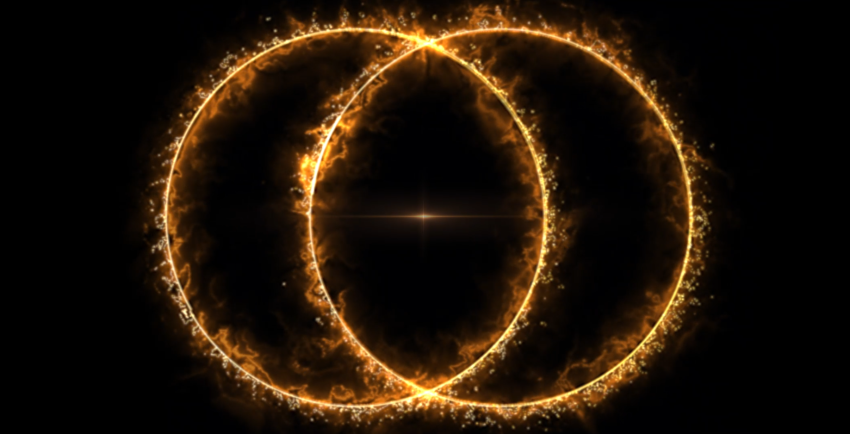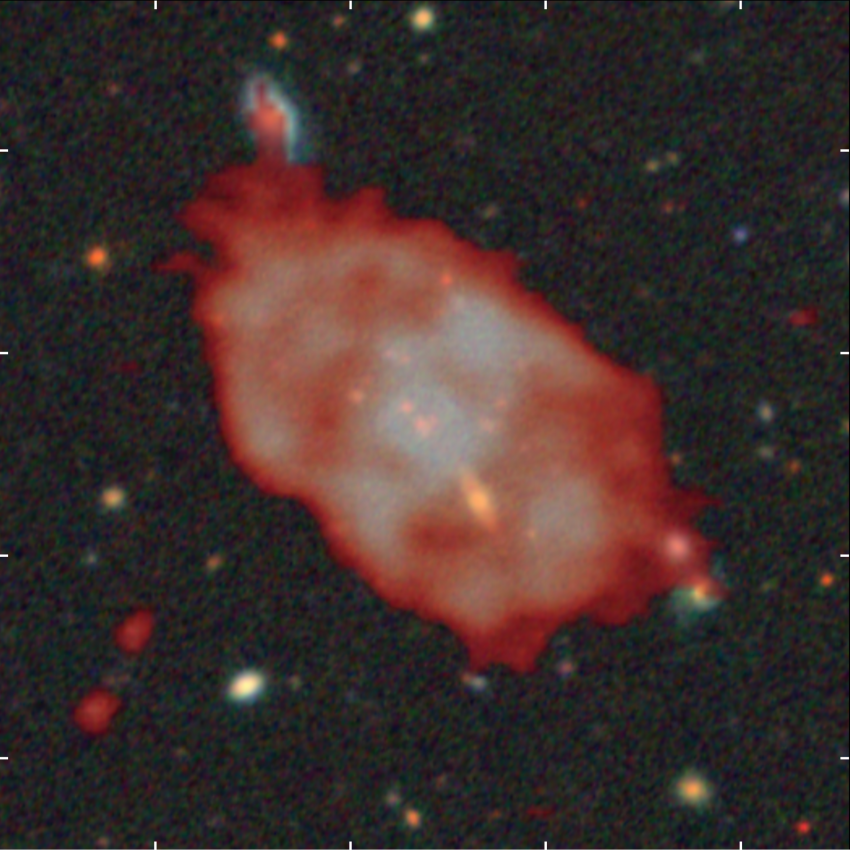The most distant and most powerful 'odd radio circle' (ORC) known so far has been discovered by astronomers.
These curious rings are a relatively new astronomical phenomenon, having been detected for the first time just six years ago. Only a handful of confirmed examples are known – most of which are 10-20 times the size of our Milky Way galaxy.
ORCs are enormous, faint, ring-shaped structures of radio emission surrounding galaxies which are visible only in the radio band of the electromagnetic spectrum and consist of relativistic, magnetised plasma. Previous research has suggested they might be caused by shockwaves from merging supermassive black holes or galaxies.
Now, a new study published today in Monthly Notices of the Royal Astronomical Society proposes that the rings of light may actually be linked to superwind outflows from spiral host radio galaxies.
Researchers led by the University of Mumbai made their discovery with the help of the RAD@home Astronomy Collaboratory citizen science platform and the Low-Frequency Array (LOFAR), the world's largest and most sensitive radio telescope operating at low frequencies (10 to 240 megahertz).
The source, designated RAD J131346.9+500320, lies nearly at redshift ~0.94 (when the universe was half its current age), making it both the most distant and the most powerful ORC known to date.
It also has not one but two intersecting rings – only the second such example with this feature – sparking more questions than answers.
Dr Ananda Hota, founder of the RAD@home Astronomy Collaboratory for citizen science research, said: "This work shows how professional astronomers and citizen scientists together can push the boundaries of scientific discovery.
"ORCs are among the most bizarre and beautiful cosmic structures we've ever seen – and they may hold vital clues about how galaxies and black holes co-evolve, hand-in-hand."
RAD J131346.9+500320 is the first ORC discovered through citizen science and the first identified with the help of LOFAR.
LOFAR is a cutting-edge pan-European radio telescope, with hundreds of thousands of simple antennas spread across the Netherlands and partner stations in many European countries. Working together as one giant interferometer, it provides an exceptionally sharp and sensitive view of the sky at low radio frequencies.
It enables astronomers to look back billions of years to a time before the first stars and galaxies formed by surveying vast areas of the low-frequency radio sky.
Alongside the new ORC discovery, the RAD@home Astronomy Collaboratory also found two other unusual cosmic giants.
The first, RAD J122622.6+640622, is a galaxy nearly three million light-years across – more than 25 times the size of our Milky Way. One of its powerful jets suddenly bends sideways, as if forced off course, and then blows a spectacular radio ring about 100,000 light-years wide.
The second, RAD J142004.0+621715, stretches across 1.4 million light-years and shows a similar ring of radio emission at the end of one of its jets, with another narrow radio jet on the other side of the host galaxy.
Both galaxies sit in crowded regions of space called galaxy clusters, where their jets likely interact with surrounding matter, million degree hot thermal plasma, which shapes these striking cosmic structures.
All three objects are found in galaxy clusters weighing about 100 trillion Suns, suggesting that interactions of relativistic magnetised plasma jets with the surrounding hot thermal plasma may help shape these rare rings.
Co-author Dr Pratik Dabhade, of the National Centre for Nuclear Research in Warsaw, Poland, said: "These discoveries show that ORCs and radio rings are not isolated curiosities – they are part of a broader family of exotic plasma structures shaped by black hole jets, winds, and their environments.
"The fact that citizen scientists uncovered them highlights the continued importance of human pattern recognition, even in the age of machine learning."
With upcoming facilities such as the Square Kilometre Array (SKA), astronomers expect many more ORCs to be uncovered.
At the same time, new optical surveys such as the Dark Energy Spectroscopic Instrument (DESI) and the Vera C. Rubin Observatory's Large Synoptic Survey Telescope (LSST) will provide the redshifts and environments of their host galaxies, helping to piece together how these mysterious rings form and evolve.
For now, the three new cosmic rings – discovered not by automated software but by sharp-eyed citizen scientists – represent an important step toward unlocking the secrets of these vast, puzzling structures.
ENDS
Media contacts
Sam Tonkin
Royal Astronomical Society
Mob: +44 (0)7802 877 700
Science contacts
Dr Ananda Hota
UM-DAE CEBS & CETACS, University of Mumbai, India
RAD@home Astronomy Collaboratory
Dr Pratik Dabhade
Astrophysics Division, National Centre for Nuclear Research, Warsaw, Poland
Images & captions
Caption: Optical RGB image from the Legacy Surveys, overlaid with radio emission in red from the LOFAR Two-Metre Sky Survey (LoTSS), showing the 'odd radio circle' (ORC) RAD J131346.9+500320.
Credit: RAD@home Astronomy Collaboratory (India)
Caption: An artistic visualisation of the rare twin-ring ORC (RAD J131346.9+500320), expanding outward after an explosive event in the central galaxy.
Credit: RAD@home Astronomy Collaboratory (India)
Caption: A still image from the animation of RAD J131346.9+500320.
Credit: RAD@home Astronomy Collaboratory (India)
Further information
The paper ‘RAD@home discovery of extragalactic radio rings and odd radio circles: clues to their origins’ by Ananda Hota and Pratik Dabhade et all. has been published in Monthly Notices of the Royal Astronomical Society. DOI: 10.1093/mnras/staf1531.
Notes for editors
About the Royal Astronomical Society
The Royal Astronomical Society (RAS), founded in 1820, encourages and promotes the study of astronomy, solar-system science, geophysics and closely related branches of science.
The RAS organises scientific meetings, publishes international research and review journals, recognises outstanding achievements by the award of medals and prizes, maintains an extensive library, supports education through grants and outreach activities and represents UK astronomy nationally and internationally. Its more than 4,000 members (Fellows), a third based overseas, include scientific researchers in universities, observatories and laboratories as well as historians of astronomy and others.
The RAS accepts papers for its journals based on the principle of peer review, in which fellow experts on the editorial boards accept the paper as worth considering. The Society issues press releases based on a similar principle, but the organisations and scientists concerned have overall responsibility for their content.
Keep up with the RAS on Instagram, Bluesky, LinkedIn, Facebook and YouTube.



